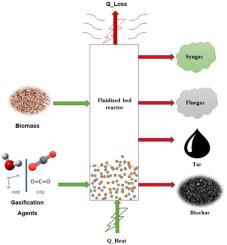Chemical Engineering Research and Design ( IF 3.7 ) Pub Date : 2020-09-22 , DOI: 10.1016/j.cherd.2020.09.017 Luis Reyes , Lokmane Abdelouahed , Jean-Christophe Buvat , Balkydia Campusano , Christine Devouge Boyer , Bechara Taouk

|
The thermodynamic study of beech wood gasification was performed in a pilot scaled fluidized bed reactor at different operation conditions, including temperature range from 600 °C to 900 °C, using CO2 and steam as gasification agents and sand and biochar as bed materials. The particularity of this study was the evaluation of energy consumption of biomass gasifier based on energy balance comparison in the same experimental set-up for different experimental conditions. The comparison between pyrolysis and gasification with CO2 showed that pyrolysis required less heat input (4.4 and 5.0 MJ/kgbiomass) than gasification (6.7 and 7.8 MJ/kgbiomass) at 800 and 900 °C respectively. Meanwhile the syngas CGE were higher for gasification (0.78) as the LHV values for syngas (12.2 MJ/kg). Temperature favoured CGE and syngas LHV increase, as it also increased process endothermicity. The presence of biochar as bed material increased the syngas LHV from 3.3 to 15.4 MJ/kg for CO2 gasification and from 3.3 to 15.1 MJ/kg for steam gasification. Both gasification agents provided similar values of CGE (>0.95) at 900 °C. From 600 to 900 °C the required heat input for steam gasification it was from 1.5 to 6.9 MJ/kgbiomass, meanwhile for CO2 gasification was from 4.1 to 7.1 MJ/kgbiomass. The results offer useful details that can help for future design of gasification experiments in fluidized bed reactors.
中文翻译:

☆在2019年10月15日至17日于法国南特举行的法国化学工程大会SFGP 2019上发表。不同气化条件下流化床反应器中榉木气化的能量研究
在中试规模的流化床反应器中,在不同的操作条件下(包括温度范围为600°C至900°C),使用CO 2和蒸汽作为气化剂,并使用沙子和生物炭作为床材料,对榉木气化进行热力学研究。这项研究的特殊性是在相同的实验设置下针对不同的实验条件,根据能量平衡比较评估生物质气化炉的能耗。热解和CO 2气化的比较表明,热解比气化(6.7和7.8 MJ / kg生物量)需要更少的热量输入(4.4和5.0 MJ / kg生物量))分别在800和900°C下进行。同时,气化的合成气CGE较高(0.78),合成气的LHV值较高(12.2 MJ / kg)。温度有利于CGE和合成气LHV的增加,因为它还会增加过程的吸热性。生物炭作为床材料的存在,对于CO 2气化,合成气LHV从3.3提高到15.4 MJ / kg,对于蒸汽气化,从3.3提高到15.1 MJ / kg。两种气化剂在900°C下的CGE值均相似(> 0.95)。在600至900°C的温度下,蒸汽气化所需的热量输入为1.5至6.9 MJ / kg生物质,而CO 2气化所需的热量输入为4.1至7.1 MJ / kg生物质。结果提供了有用的细节,可帮助将来设计流化床反应器中的气化实验。











































 京公网安备 11010802027423号
京公网安备 11010802027423号